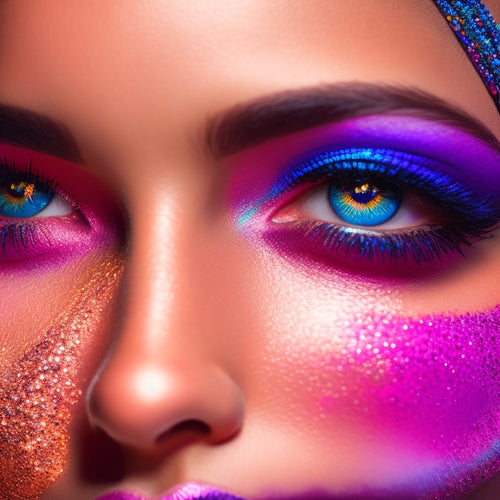
Capturing Dance Recital Magic: Flash-Free Techniques
Share
You're about to discover the magic of a dance recital, but dim lighting threatens to ruin the shot - and using a flash is not an option! Don't let low-light sabotage your photography. Mastering low-light photography means anticipating dancers' movements, positioning yourself strategically, and focusing on creative compositions. Shoot in manual mode, opt for a wide aperture, and increase ISO settings. For flash-free techniques, prioritize movement anticipation, utilize a wide aperture lens, and maintain a fast shutter speed. You're one step away from capturing stunning dance recital photos - now, take the next step to reveal the secrets to engaging, flash-free photography!
Key Takeaways
• Prioritize movement anticipation to capture fleeting moments of dance recital magic.
• Utilize a wide aperture lens (around f/4) to create a shallow depth of field and emphasize the dancers.
• Maintain a fast shutter speed (1/200 sec or higher) to freeze movement and convey energy.
• Avoid using flash to preserve the natural ambiance and avoid distractions.
• Use a monopod to enhance stability and ensure sharp images in low-light conditions.
Mastering Low-Light Photography
When you're tasked with capturing the magic of a dance recital, you're often faced with the challenge of mastering low-light photography, where the dimly lit stage and fleeting movements of the dancers demand skill, creativity, and the right techniques to produce stunning images.
You'll need to overcome the low light challenges that come with indoor events, where the lack of natural light can make it difficult to freeze the action. To rise to the occasion, focus on creative compositions that prioritize movement and expression. Anticipate the dancers' movements, and position yourself to capture the perfect shot.
Camera Settings for Success
As you prepare to capture the dynamic movements of the dancers, it's time to fine-tune your camera settings to make sure you're poised for success in the low-light environment.
To master the art of capturing dance recital magic, you need to get your camera settings just right.
Here are some essential tips to get you started:
-
Shoot in manual mode to control exposure and avoid overexposure.
-
Opt for a wide aperture (around f/4) to create a shallow depth of field and separate the dancers from the background.
-
Increase your ISO settings (2000 or higher) to compensate for the lack of light.
-
Use a fast shutter speed (1/200 sec or higher) to freeze the dancers' movements.
-
Anticipate the dancers' movements and compose your shots accordingly to capture the perfect moment.
Flash-Free Techniques Uncovered
To explore the dynamic energy of the dancers without disrupting the performance, you'll want to master flash-free techniques that harness the available light. We're about to uncover the secrets of doing just that.
In low light composition, it's crucial to prioritize movement anticipation. As you prepare to snap that perfect shot, anticipate the dancer's next move, focusing on well-lit areas of the stage.
With a wide aperture lens and high ISO settings, you'll be able to capture the magic of the performance without relying on flash. Remember to maintain a fast shutter speed to freeze the action, and consider using a monopod for added stability.
Frequently Asked Questions
How Do I Handle Sudden Changes in Stage Lighting During a Recital?
"Did you know 75% of photographers struggle with sudden lighting changes? To handle them, you'll master light metering and exposure bracketing - anticipating shifts, adjusting ISO, and capturing a range of exposures to merge later."
What Are Some Creative Ways to Incorporate Dance Movement Into My Photos?
You're capturing dance recital magic! Freeze motion with fast shutter speeds or create mesmerizing motion blur by slowing down - either way, you'll convey the dynamic energy of the performance, immortalizing frozen moments in time.
Can I Use a Tripod to Stabilize My Camera in a Darkened Theater?
As you sway to the rhythm of the darkened theater, you ponder: can a tripod stabilize your camera? Yes, it can! It'll help you achieve camera balance, ensuring low light focus and capturing the dancers' mesmerizing moves with precision.
How Can I Capture the Emotional Intensity of a Dancer's Performance?
You zero in on the dancer's fiery gaze, capturing the intensity of their performance through subtle facial expressions and powerful body language, conveying the emotional depth of their movement.
Are There Any Specific Camera Settings for Capturing Fast-Paced Dance Movements?
As you're transported to a whirlwind of spinning tutus and flying limbs, prioritize shutter speed to freeze the frenzy, opting for shutter priority mode and advanced autofocus modes to capture the dynamic dance movements with razor-sharp clarity.
Related Posts
-

Revolutionize Your Dance Makeup With Pro Tutorials
You're about to discover the hidden gems of your dance makeup skills with the latest digital tools and expert guidanc...
-

Innovative Therapy: Dance Movement's Healing Power
Dance movement therapy is a creative and evidence-based approach that harnesses the transformative power of movement ...
-

Mastering Dance Photography: Expert Tips and Techniques
You're about to excel in dance photography, a challenging field where only a few succeed. To join the elite 10%, you'...


